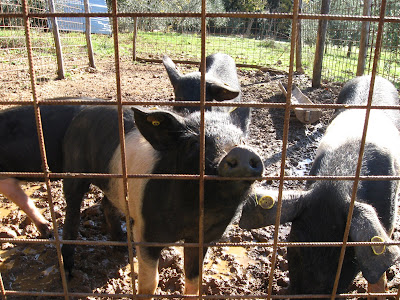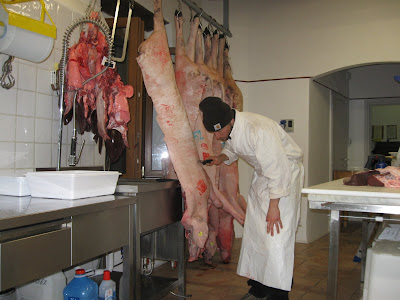


First, I'll say that tripe is not a place it is a food. Actually, it may very well be a place, but I've never heard of it and I wanted to be specific since the title could be misleading. My adventure in tripe took place at a Slow Food dinner in Siena, Italy; near where I am living. It just so happens that Italy is the birthplace of the Slow Food movement and it started in Rome in 1986 as a way to protest the opening of a McDonald's. Over 20 years later, it has grown to have some 83,000 members in 122 countries. My boss, Riccio, is a member and consequently, his membership gave me access to the dinner and my first experience with tripe. Although, it is likely that I've eaten tripe in some form before the dinner. Perhaps it was neatly disguised as scrapple, within a hot dog or sausage; or in the Pho at my favorite Vietnamese restaurant. But this experience was actually enough to have my tingling with excitement and snapping pictures of the dishes as they arrived. And I had plenty of picture taking to do as the food kept coming over the span of 3 and half hours. The meal consisted only of beef tripe and several offal items. The antipasto alone had stomach, white tripe and part of the udder. We also enjoyed beef tongue, two different parts of the feet, two varieties of stomach (remember, cow's have four stomachs), and even parts of the female reproductive organs. The offerings throughout the night were served both hot and cold. We dined on boiled "mixed" tripe, centropelle (a stomach) soup and ravioli of lampredotto (another stomach). I really had only one reservation as mealtime approached and that was the texture. I'm very texturally sensitive when it comes to my food, but only the cold white tripe salad presented a challenge to me. Everything was prepared very well and in some cases left me wanting more. My favorite was the "lampredotto" variety featured on the small sandwich above. It was incredibly tender and reminded me very much of thinly-sliced roast beef. Curiously enough, I saw lampredotto being featured on a street vendor's food cart while in Florence and opted for something else. Florence is quite famous for its lampredotto and now I know to partake on my next visit. It was also a real pleasure to be part a such a large group of people who take food so seriously and embrace the local and regional traditions. I left feeling very thankful for another unique Italian experience and a little over-stuffed. The dinner was fun for me and my friends and we even joked that had they served us "tripamisu" (thanks Rusty) we would have delightfully eaten that too.



















